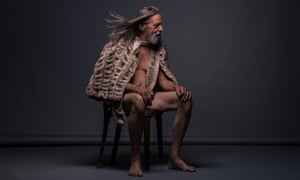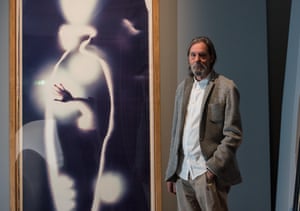Performance art
From his nude stunts with Marina Abramović to swiping an artwork adored by the Führer, Ulay was a performance art trailblazer. Our writer recalls his finest aktions – and the countless hours they spent chatting and smoking
Noah Charney
Tue 3 Mar 2020

‘You are an artist even when you are asleep’ … Ulay. Photograph: Primoz Korosec
Ifirst met Ulay at a dinner party thrown by Slovenia’s most famous rock star. The musician’s wife prepared salt-baked fish and, as she cracked open the crust, I felt the gush of a groupie as I looked through the steam at Ulay, a man I had studied in art history class, now sitting across the table from me.
Ulay, as the man born Frank Uwe Laysiepen was known, was an exceptionally influential photographer and performance artist. He will be mourned by the art world as one of the greats of the postmodern era. But I will miss him as a wonderful, kind friend who happened to be an ingenious artist as well.
Like me, Ulay married a Slovenian woman and settled down in Ljubljana, on the sunny side of the Alps. He was one of a handful of living artists enshrined in most Introduction to Art History textbooks. You can find him in the last chapter, after you’ve combed over Lysippus and Giotto, Donatello and Michelangelo, Ingres and Picasso. There he is, usually in conjunction with his one-time, long-term romantic and artistic partner, Marina Abramović.
In the late 1970s and 80s, their work as a duo was seminal to the course of performance art (though Ulay always preferred the German word aktion). Yet they were also great artists in their separate careers. Ulay began as a photographer, one of the few official representatives of Polaroid in the 60s, even though he did go on to become more famous for his performance art – most memorably 1976’s There Is a Criminal Touch to Art, when he successfully stole Hitler’s favourite painting from a Berlin museum and brought it to hang on the wall of an impoverished Turkish immigrant family. He then called the authorities to come and retrieve it. This was art theft as artwork.

Tight squeeze … a visitor walks between performers in a re-creation of Abramović and Ulay’s Imponderabilia. Photograph: Christian Hartmann/Reuters
His independent career touched on shifting genders decades before this was fashionable. He invented a hybrid-gendered alter ego, Renais Sense, making up one side of his face like a woman’s and the other like a man’s. He was a pioneer in body art, considering the body to be the artistic medium par excellence, and he was also a believer in shock as an artistic tactic.
In Imponderabilia, one of the most famous performance artworks of all time, he and Abramović stood naked in a narrow gallery doorway, forcing visitors to shimmy past them, sidling sideways, confronting either his nakedness or hers. Other works included a performance in which they took turns slapping each other, interested in the sound this made. In another, they repeatedly ran naked smashing into columns in a car park with their shoulders. The columns were unattached and had been placed on sleds, so they would slide slightly backwards with each strike. But they were heavy and caused bruising nonetheless.
Later works examined the physical capabilities of the human body. Nightsea Crossing was a series of 22 performances over 90 days in which the two would sit opposite each other, completely still, for many hours at a time. Both practised ayurvedic meditation and trained extensively for these performances, which required incredible concentration and mental strength. In interviews with Ulay, he explained to me how they trained themselves to “scratch itches with our minds”. Buzzing flies, not to mention audience members who made a game of trying to distract them, were among the many obstacles.
Ulay and Abramović will always be intertwined, even though they eventually had a falling out. Afterwards, the two met by chance, or fate, at an ayurvedic retreat in rural India. Ulay was there with his talented wife, designer Lena Pislak, who has been his constant companion, support and driving force for years now. But what could have been very awkward was not. The two artists decided to put the issue aside, and became friendly again, against all odds. Years later, they even discussed writing a joint memoir.
Hands free … Ulay stands next to Self-Portrait, from 1990.
Photograph: Dpa Picture Alliance/Alamy Stock Photo
There was a fatherly guru vibe about Ulay. When he emailed or texted me, he would call me “Dear”. He took up activist causes, calling himself an “artivist” for clean water. He spoke poetically, eloquently, with the sort of phrases you want to jot down, or carve in stone, even in casual conversation. “One can learn many things in life,” he once said, “but not art. The madness you need – the must which is shaking you all the time. You are an artist even when you are asleep. Because of the must.” He was an artist to the bone.
His legacy will be kept alive by the Ulay Foundation, which opened last year in Ljubljana. Ulay was, above all, a man of enormous warmth and kindness. I spent countless hours at his kitchen table in his sunny Ljubljana apartment, sharing his Marlboros and drinking a special healthy brew, which he liked to call his magic potion, prepared for him by Lena.
We had planned to write a book together, but never found the time to finish it. He had beaten cancer twice already (once documented in the film Project Cancer). Each time, he had gone on an ayurvedic retreat and that, combined with the help of the oncology clinic in Ljubljana, had sent his cancer into remission. Against all odds, with the loving support of those closest to him, he remained remarkably active, even in sickness. “Death is the ultimate answer,” he said. “But life is absolute.”
At one point, he had considered his illness and the documentation of it as a type of performance. It would be his ultimate aktion.
Ifirst met Ulay at a dinner party thrown by Slovenia’s most famous rock star. The musician’s wife prepared salt-baked fish and, as she cracked open the crust, I felt the gush of a groupie as I looked through the steam at Ulay, a man I had studied in art history class, now sitting across the table from me.
Ulay, as the man born Frank Uwe Laysiepen was known, was an exceptionally influential photographer and performance artist. He will be mourned by the art world as one of the greats of the postmodern era. But I will miss him as a wonderful, kind friend who happened to be an ingenious artist as well.
Like me, Ulay married a Slovenian woman and settled down in Ljubljana, on the sunny side of the Alps. He was one of a handful of living artists enshrined in most Introduction to Art History textbooks. You can find him in the last chapter, after you’ve combed over Lysippus and Giotto, Donatello and Michelangelo, Ingres and Picasso. There he is, usually in conjunction with his one-time, long-term romantic and artistic partner, Marina Abramović.
In the late 1970s and 80s, their work as a duo was seminal to the course of performance art (though Ulay always preferred the German word aktion). Yet they were also great artists in their separate careers. Ulay began as a photographer, one of the few official representatives of Polaroid in the 60s, even though he did go on to become more famous for his performance art – most memorably 1976’s There Is a Criminal Touch to Art, when he successfully stole Hitler’s favourite painting from a Berlin museum and brought it to hang on the wall of an impoverished Turkish immigrant family. He then called the authorities to come and retrieve it. This was art theft as artwork.

Tight squeeze … a visitor walks between performers in a re-creation of Abramović and Ulay’s Imponderabilia. Photograph: Christian Hartmann/Reuters
His independent career touched on shifting genders decades before this was fashionable. He invented a hybrid-gendered alter ego, Renais Sense, making up one side of his face like a woman’s and the other like a man’s. He was a pioneer in body art, considering the body to be the artistic medium par excellence, and he was also a believer in shock as an artistic tactic.
In Imponderabilia, one of the most famous performance artworks of all time, he and Abramović stood naked in a narrow gallery doorway, forcing visitors to shimmy past them, sidling sideways, confronting either his nakedness or hers. Other works included a performance in which they took turns slapping each other, interested in the sound this made. In another, they repeatedly ran naked smashing into columns in a car park with their shoulders. The columns were unattached and had been placed on sleds, so they would slide slightly backwards with each strike. But they were heavy and caused bruising nonetheless.
Later works examined the physical capabilities of the human body. Nightsea Crossing was a series of 22 performances over 90 days in which the two would sit opposite each other, completely still, for many hours at a time. Both practised ayurvedic meditation and trained extensively for these performances, which required incredible concentration and mental strength. In interviews with Ulay, he explained to me how they trained themselves to “scratch itches with our minds”. Buzzing flies, not to mention audience members who made a game of trying to distract them, were among the many obstacles.
Ulay and Abramović will always be intertwined, even though they eventually had a falling out. Afterwards, the two met by chance, or fate, at an ayurvedic retreat in rural India. Ulay was there with his talented wife, designer Lena Pislak, who has been his constant companion, support and driving force for years now. But what could have been very awkward was not. The two artists decided to put the issue aside, and became friendly again, against all odds. Years later, they even discussed writing a joint memoir.

Hands free … Ulay stands next to Self-Portrait, from 1990.
Photograph: Dpa Picture Alliance/Alamy Stock Photo
There was a fatherly guru vibe about Ulay. When he emailed or texted me, he would call me “Dear”. He took up activist causes, calling himself an “artivist” for clean water. He spoke poetically, eloquently, with the sort of phrases you want to jot down, or carve in stone, even in casual conversation. “One can learn many things in life,” he once said, “but not art. The madness you need – the must which is shaking you all the time. You are an artist even when you are asleep. Because of the must.” He was an artist to the bone.
His legacy will be kept alive by the Ulay Foundation, which opened last year in Ljubljana. Ulay was, above all, a man of enormous warmth and kindness. I spent countless hours at his kitchen table in his sunny Ljubljana apartment, sharing his Marlboros and drinking a special healthy brew, which he liked to call his magic potion, prepared for him by Lena.
We had planned to write a book together, but never found the time to finish it. He had beaten cancer twice already (once documented in the film Project Cancer). Each time, he had gone on an ayurvedic retreat and that, combined with the help of the oncology clinic in Ljubljana, had sent his cancer into remission. Against all odds, with the loving support of those closest to him, he remained remarkably active, even in sickness. “Death is the ultimate answer,” he said. “But life is absolute.”
At one point, he had considered his illness and the documentation of it as a type of performance. It would be his ultimate aktion.
No comments:
Post a Comment